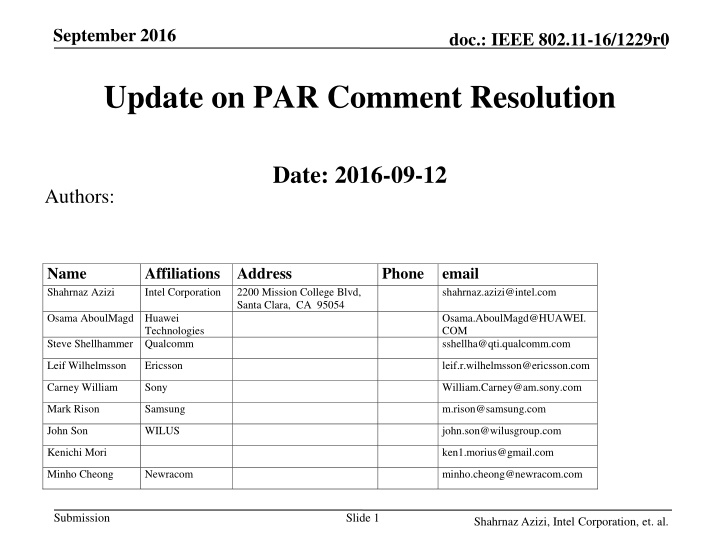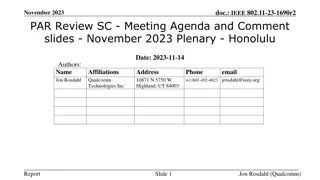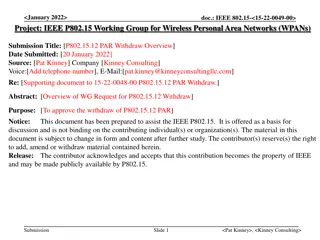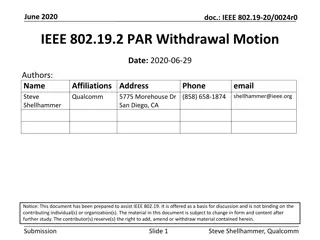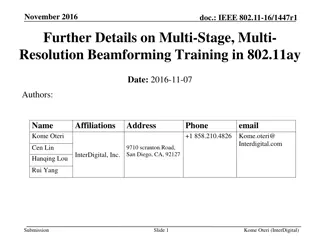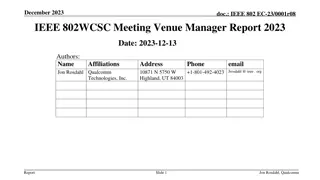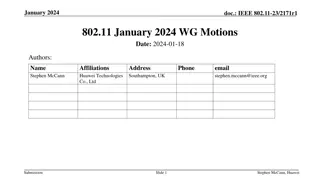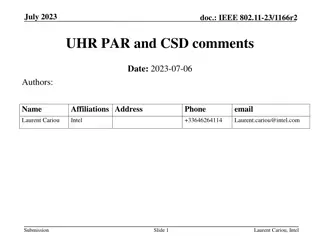IEEE 802.11-16/1229r0 Update on PAR Comment Resolution
The document from September 2016 provides an update on the resolution of comments related to the IEEE 802.11-16/1229r0 standard. It includes discussions on various topics such as user data, different bands, operation, latency, and miscellaneous issues. Feedback was collected through email threads and conference calls, leading to proposed resolutions for different categories like user data. The document reflects the progress made during the August 29, 2016 conference call.
Download Presentation

Please find below an Image/Link to download the presentation.
The content on the website is provided AS IS for your information and personal use only. It may not be sold, licensed, or shared on other websites without obtaining consent from the author.If you encounter any issues during the download, it is possible that the publisher has removed the file from their server.
You are allowed to download the files provided on this website for personal or commercial use, subject to the condition that they are used lawfully. All files are the property of their respective owners.
The content on the website is provided AS IS for your information and personal use only. It may not be sold, licensed, or shared on other websites without obtaining consent from the author.
E N D
Presentation Transcript
September 2016 doc.: IEEE 802.11-16/1229r0 Update on PAR Comment Resolution Date: 2016-09-12 Authors: Name Shahrnaz Azizi Affiliations Address Intel Corporation Phone email shahrnaz.azizi@intel.com 2200 Mission College Blvd, Santa Clara, CA 95054 Osama AboulMagd Huawei Osama.AboulMagd@HUAWEI. COM sshellha@qti.qualcomm.com Technologies Steve Shellhammer Qualcomm Leif Wilhelmsson Ericsson leif.r.wilhelmsson@ericsson.com Carney William Sony William.Carney@am.sony.com Mark Rison Samsung m.rison@samsung.com John Son WILUS john.son@wilusgroup.com Kenichi Mori ken1.morius@gmail.com Minho Cheong Newracom minho.cheong@newracom.com Submission Slide 1 Shahrnaz Azizi, Intel Corporation, et. al.
September 2016 doc.: IEEE 802.11-16/1229r0 Authors (cont d) : Name Eduard Garcia- Villegas Esung Park Affiliations Address UPC Phone email eduardg@entel.upc.edu LGE esung.park@lge.com' Yongho Seok Newracom yongho.seok@newracom.com Igor Kim ETRI ikim@etri.re.kr Sung-Hyun Hwang ETRI shwang@etri.re.kr James Lepp BlackBerry jlepp@ieee.org Jae Seung Lee ETRI jasonlee@etri.re.kr Reza Hedayat Newracom reza.hedayat@newracom.com yao.ke5@zte.com.cn Ke Yao ZTE Jinsoo Choi LGE js.choi@lge.com Shimi Shilo Huawei Shimi.Shilo@huawei.com Ping Fang Huawei Device ping.fang@huawei.com Submission Slide 2 Shahrnaz Azizi, Intel Corporation, et. al.
September 2016 doc.: IEEE 802.11-16/1229r0 Authors (cont d) : Name Bo Sun Affiliations Address ZTE Phone email sun.bo1@zte.com.cn HanGyu Cho LGE Pilot Research hg.cho@lge.com Francois Simon fygs@pilotresearch.com Ansley, Carol Arris Carol.Ansley@arris.com Jinsam Kwak WILUS jinsam.kwak@wilusgroup.com Kiseon Ryu LGE kiseon.ryu@lge.com Min Seok LGE minseok.oh@lge.com Saishankar Nandagopalan Sung Eun Lee Cypress snan@cypress.com Cypress SULE@cypress.com Yangxun David Huawei david.yangxun@huawei.com Junghoon Suh Huawei Junghoon.Suh@huawei.com Lei Wang Marvell leileiw@marvell.com Submission Slide 3 Shahrnaz Azizi, Intel Corporation, et. al.
September 2016 doc.: IEEE 802.11-16/1229r0 Background Comments were categorized in five groups: 1. User data 2. Different bands 3. Operation 4. Latency 5. Miscellaneous Resolutions were discussed through email threads, and WUR conference calls. During the Aug 29, 2016 WUR conference call, document 1119r0 was presented, reviewed and feedbacks were collected which are reflected in this document. Submission Slide 4 Shahrnaz Azizi, Intel Corporation, et. al.
September 2016 doc.: IEEE 802.11-16/1229r0 Category 1: User data Proposed resolution was to modify as follows: The wake-up packets carry only control information, and they do not carry any user payload data. Three sets of opinions: 1. Remove the user data part: The wake-up packets carry only control information, and they do not carry any user payload data. 2. Keep (only) the user data part: The wake-up packets carry only control information, and they do not carry any user payload data. 3. Remove the entire sentence Remedy: run a straw poll to finalize Submission Slide 5 Shahrnaz Azizi, Intel Corporation, et. al.
September 2016 doc.: IEEE 802.11-16/1229r0 Category 2: Different bands Proposed resolution was to modify as follows: This amendment defines operations for 2.4 GHz and 5 GHz bands. The wake-up packet may be transmitted in the same band or in a different band other that the primary connectivity radio is using. Have consensus on this resolution. There was a question on whether Sub1GHz should be added, which was cleared after pointing that Sub1GHz is already mentioned in the explanatory section Submission Slide 6 Shahrnaz Azizi, Intel Corporation, et. al.
September 2016 doc.: IEEE 802.11-16/1229r0 Category 3: Operation Proposed resolution was to modify as follows: The reception of the wake-up packet by the WUR may triggers a transition of the primary connectivity radio (used for transfer of normal 802.11 packets) to come out of from sleep to normal operation. Have consensus on this resolution with the following change: The reception of the wake-up packet by the WUR can triggers a transition of the primary connectivity radio (used for transfer of normal 802.11 packets) out of from sleep to normal operation. Submission Slide 7 Shahrnaz Azizi, Intel Corporation, et. al.
September 2016 doc.: IEEE 802.11-16/1229r0 Category 4: Latency Resolutions proposed in the email exchange are as follows: 5.5 Need for the Project: Prolonging the battery lifetime while in some use cases also maintaining low latency becomes an imperative requirement. Therefore, for the 802.11 standard to be competitive, the IEEE 802.11 WG needs to develop power efficient mechanisms to be used with battery- operated devices while maintaining low latency where it is required. 8.1 Additional Explanatory Notes (Item Number and Explanation):re 5.2.b In scenarios where low latency is a requirement, tThe WUR should decreases overall power consumption of the STA without significant increasein impact to the latency (relative to the current maximum latency of the nominal duration of one beacon interval, 102.4 ms) in transferring user data packets. Submission Slide 8 Shahrnaz Azizi, Intel Corporation, et. al.
September 2016 doc.: IEEE 802.11-16/1229r0 Category 5: Miscellaneous Proposed resolution was to modify as follows: 5.5 Need for the Project: Change smart phones to smartphones 8.1 Additional Explanatory Notes (Item Number and Explanation): 5.2.b Add an extra bullet In order to enable a wider set of use cases, both AP and non-AP types of STAs can be equipped with a WUR that can receive wake-up messages. Submission Slide 9 Shahrnaz Azizi, Intel Corporation, et. al.
September 2016 doc.: IEEE 802.11-16/1229r0 Straw Poll 1 Do you agree to remove the user data part in order to have the following text: The wake-up packets carry only control information. Yes: 35 No: 0 Abstain: 24 Submission Slide 10 Shahrnaz Azizi, Intel Corporation, et. al.
September 2016 doc.: IEEE 802.11-16/1229r0 Straw Poll 1- alternative Which of the following option do you prefer: A. Remove the user data part: The wake-up packets carry only control information, and they do not carry any user payload data. B. Keep (only) the user data part: The wake-up packets carry only control information, and they do not carry any user payload data. C. Remove the entire sentence: The wake-up packets carry only control information, and they do not carry any user payload data. A: 29 B: 4 C: 10 Abstain: 11 Slide 11 Submission Shahrnaz Azizi, Intel Corporation, et. al.
